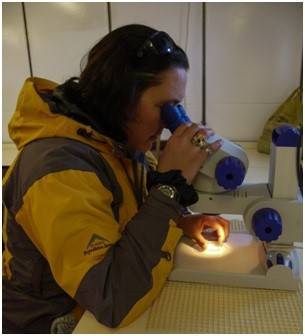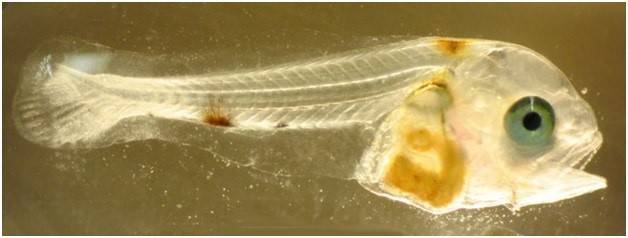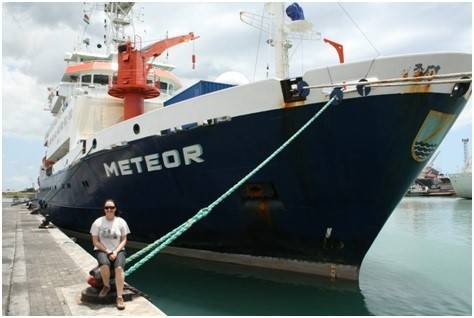Possible new fish species discovered in the Baakens River
There are a few interesting research projects taking place in Nelson Mandela Bay. Dr Nadine A. Strydom conducts research on fishes at NMMU and is based in the Zoology Department. Her fish research at NMMU fills a unique national niche area focused on young fishes occurring in shallow water nursery areas in a variety of habitats in South Africa: nearshore ocean, estuaries and more recently, rivers and lakes in Nelson Mandela Bay.
Most marine fish hatch from eggs that are spawned by adults in the ocean. The larvae of these species undergo a metamorphosis as they drift shorewards aided by wind and tide driven currents. Once larvae develop a caudal (tail) fin, they become very competent swimmers that make their way to shallow water nursery areas along the South African coast, particularly estuaries, surf zones and nearshore reefs. The success of any fish population is underpinned by the success of the larval phase. Larvae need to seek out suitable food-rich, sheltered nurseries in order to grow into juvenile fish. It is in this phase of the life cycle that scientists know very little. In the past decade, Dr Strydom has made significant progress in the understanding of the early life history requirements, including nursery areas, for coastal fishes thereby furthering knowledge, conservation and management of South African fishes.
In 2013, Dr Strydom had numerous postgraduate research projects underway. An extensive PhD study into the habitat use of larval stage fishes in Algoa Bay was completed. This work assessed the role of different types of habitats, such as reefs, estuary mouths and surf zones, in the Bay in the settlement choices of young fishes. Novel new approaches were used to model fish spawning areas using regressive vector plotting techniques in conjunction with an oceanographer. New information has come to light about fish spawning along the EC coast. It was previously thought that important species like Dusky kob spawn offshore, but findings from NMMU research show this species and others to be spawning in and near Algoa Bay. Three papers have been published from this study with a further two in review with international journals.
An extensive research cruise aboard the METEOR, a German research vessel, was undertaken in 2013 following a cruise track from Walvis Bay, Namibia to Mauritius in the western Indian Ocean. This trip enabled sample collection of fish larvae in the Agulhas Current off Port Elizabeth to supplement species being described in a book being written by Dr Strydom on the early stage fishes of temperate South Afrcia. The cruise has also facilitated collaboration with world leaders in the oceanography of the Agulhas Current. A new joint research project on the entrainment or loss of pelagic fish larvae from the Agulhas Current is underway in collaboration with Dr Arne Biastoch from GEOMAR, Kiel, Germany.
Dr Strydom is also studying pelagic fishery species (Anchovy and Sardine) and the role that the Algoa Bay Region serves as a spawning and larval grow-out area. It was long believed that sardine spawn only off the west coast of South Africa but Dr Strydom’s research has shown that a viable spawning population exists in the region. It is still unknown how well the larvae of these species do in a relatively nutrient poor bay when compared with the typical food-rich upwelling zones off the west coast where spawning usually occurs. In collaboration with a colleague from GEOMAR in Kiel, Germany, Dr Strydom has brought a unique biochemical technique to South Africa to assess body condition of sardine and anchovy larvae in Algoa Bay and compared these to west coast larvae to assess the general health and survival probabilities of local larvae. The technique makes use of RNA:DNA ratios in body tissues as an indicator of fish growth.
Dr Strydom first applied this technique in an estuarine context in 2013, fine-tuning the method for new applications assisted by a post-doctoral student and Prof Carminita Frost in the Biochemistry NMMU. This technique was successfully reworked for a world-first application in estuaries to assess body condition of the estuary round-herring, a close cousin of the sardine, in response to varying food patch quality in estuaries. The herring is an important fodder fish in estuaries and densities of this species underpins the success of fish populations in estuaries.
The first ever comprehensive pollution study on the Swartkops Estuary was completed to assess the accumulation of heavy metals and organic pollutants in the food chain, culminating in fish and birds. Many people eat the fish from this urban estuary and new findings have resulted in consultation with the Municipality to caution the consumption of fish from the Swartkops. Fish tissues were found to be loaded with Cadmium, often far in excess of international safe standards for food stuffs. This work has resulted in further collaboration with the Dept. of Water Affairs local scientists to source the origin of Cadmium and other heavy metals polluting the fishes in the estuary.

Potentially new species of goby, Stenogobius polyzona collected by Dr Strydom and her student in the lower Baakens River, just above the tidal head of the estuary near the Bridge Street Brewery.
Ongoing work on estuaries includes fine-scale habitat use by fishes in regional estuaries, including assessing the effects of climate change water-chemistry scenarios on common marine fishes using estuaries as nursery areas. Some local estuarine work has expanded into the adjoining rivers. The Baakens River in the metro is the focus of current research, initiated in 2013, to assess the population status of endangered fishes in the system. Concerns over the status of fishes were raised by members of the community after frequent sewage spills and domestic waste dumping into the Baakens River. Findings from this study have highlighted the plight of the Eastern Cape redfin, whose population is now on the brink of local extinction in the Baakens, primarily as a result of poor water quality in the Baakens, siltation of spawning areas for this fish and the population of an aggressive alien fish, the southern Mouth Brooder, introduced into the Baakens by members of the public as unwanted aquarium fish. This work is being undertaken in conjunction with Dr Olaf Weyl of the South African Institute for Aquatic Biodiversity. The Baakens River is also home to rare fishes, the current study has revealed a potentially new species of fish but more specimens are required for genetic analysis of the species.
Categories
Featured Posts
-
Unleash the Summer: Essential Travel Hacks for Saving, Safety and Smart Packing
As the temperature rises and the days grow longer, the allure of summer travel becomes…
-

Gqeberha: Tales of Adventure and Exploration
Although this adventure quote might sound cliche and a bit overused, it’s one thing that…
-

101 Things to do in and around Nelson Mandela Bay (Port Elizabeth/Gqeberha)
With an abundance of things to see and do in and around Gqeberha (Port Elizabeth), it is…


